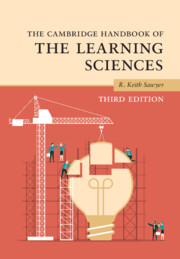Book contents
- The Cambridge Handbook of the Learning Sciences
- The Cambridge Handbook of the Learning Sciences
- Copyright page
- Contents
- Figures
- Tables
- Contributors
- Preface
- 1 An Introduction to the Learning Sciences
- Part I Foundations
- Part II Methodologies
- Part III Grounding Technology in the Learning Sciences
- Part IV Learning Together
- Part V Learning Disciplinary Knowledge
- Part VI Moving Learning Sciences Research into the Classroom
- 29 Learning as a Cultural Process
- 30 Designing for Meaningful Learning
- 31 Advances in Teacher Learning Research in the Learning Sciences
- 32 Learning Sciences and Policy
- 33 The Learning Sciences in the 2020s: Implications for Schools and Beyond
- Index
- References
32 - Learning Sciences and Policy
A Decade of Mutual Engagement
from Part VI - Moving Learning Sciences Research into the Classroom
Published online by Cambridge University Press: 14 March 2022
- The Cambridge Handbook of the Learning Sciences
- The Cambridge Handbook of the Learning Sciences
- Copyright page
- Contents
- Figures
- Tables
- Contributors
- Preface
- 1 An Introduction to the Learning Sciences
- Part I Foundations
- Part II Methodologies
- Part III Grounding Technology in the Learning Sciences
- Part IV Learning Together
- Part V Learning Disciplinary Knowledge
- Part VI Moving Learning Sciences Research into the Classroom
- 29 Learning as a Cultural Process
- 30 Designing for Meaningful Learning
- 31 Advances in Teacher Learning Research in the Learning Sciences
- 32 Learning Sciences and Policy
- 33 The Learning Sciences in the 2020s: Implications for Schools and Beyond
- Index
- References
Summary
This chapter describes three strategies for learning scientists to contribute to policymaking and implementation. First, educational systems design and redesign – where all aspects of school systems (curriculum, assessment, teacher professional development, school leadership, resources to coordinate and maintain instructional quality) are designed to improve instructional quality and redress educational inequities. Second, formative implementation research that studies both micro- and macro-levels of systems including classrooms and schools, local administrative offices, and regional education agencies as well as community organizations and cultural institutions. Third, family- and community-centered organizing to pursue systematic societal transformation, such as shifting power relations and addressing systemic oppression in society.
Keywords
- Type
- Chapter
- Information
- The Cambridge Handbook of the Learning Sciences , pp. 638 - 657Publisher: Cambridge University PressPrint publication year: 2022



